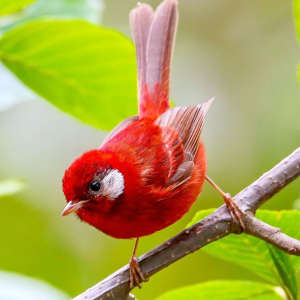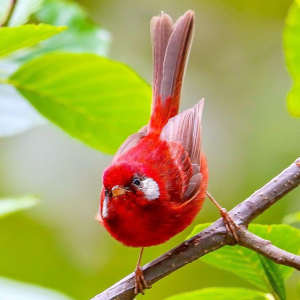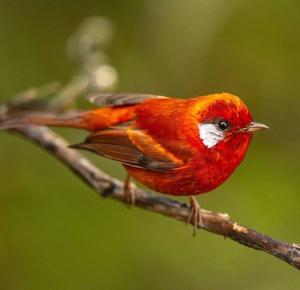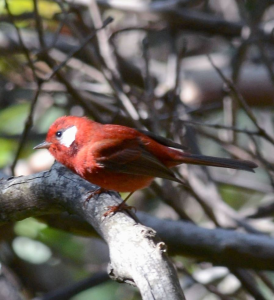A tiny bright-red bird that is unmistakable not only because of its color but also because of its hyperactive state!
The red warbler (Cardellina rubra) is a tiny and hyperactive bird that stands out not only because of its bright red color but also due to its energetic behavior.
Measuring between 12.5 to 13.5 cm (4.9 to 5.3 in) in length and weighing around 7.6 to 8.7 g (0.27 to 0.31 oz), the red warbler is easily recognizable. Both adult males and females display a predominantly red plumage, with a white or dark gray auricular patch on the sides of their heads, depending on the subspecies. The wings and tail have a slightly darker, dusky red color with pinkish-red edges. The legs are a dull red-brown, and the bill is pinkish-gray with a dark tip. Their iris is dark brown to blackish.
The photograph titled “Chipe Rojo, Red Warbler, Ergaticus ruber” (cropped) by Amado Demesa from DF, México, is licensed under CC BY-SA 2.0.
This species is endemic to Mexico and can be found from southern Chihuahua to southern Hidalgo. The red warbler prefers humid and semi-humid forests, such as pine, pine-oak, fir, and oak forests, primarily at high altitudes ranging from 2,000 to 3,500 m.
Red warblers are commonly found foraging in trees with dense foliage, particularly in conifers, where they search for various insects, including caterpillars, on the outer branches. They exhibit a hovering-gleaning behavior similar to flycatchers to catch their prey.
When it comes to nesting, red warblers build cup-shaped nests in hollows on the ground. These nests are often situated on slopes in open areas or at the base of woody plants. The nest site sometimes features an overhang provided by a plant stem, log, or rock, which offers concealment and protection. The female constructs the nest using bark, leaves, or pine needles, lining it with grasses or animal hair. Only the female incubates the eggs for about 16 days, but both parents contribute to feeding the hatchlings. The chicks fledge after approximately 10 to 11 days.
The red warbler is classified as “Least Concern” on the IUCN Red List. While it has a large breeding range and a global population estimated at 50,000 to 500,000 individuals, ongoing habitat destruction poses a threat to its population, suggesting a decline in numbers.
Hits: 0











